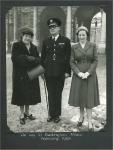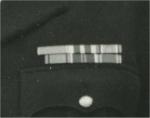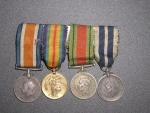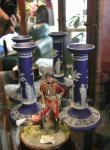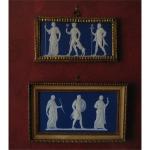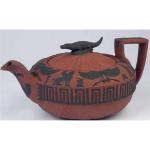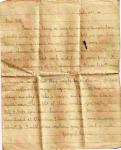-
Posts
701 -
Joined
-
Last visited
-
Days Won
1
Content Type
Profiles
Forums
Blogs
Gallery
Events
Store
Everything posted by ColinRF
-
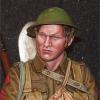
Confused by Grand dad's medal bar
ColinRF replied to ColinRF's topic in Great Britain: Orders, Gallantry, Campaign Medals
So this is all I found at Kew. Thanks again arthur. Only cost me 3 quid too. The AH Finney I saw on Ancestry is not my Grandfather but this at least shows his WWI service and arm so I consider my mystery solved. Thanks to all who asssisted and commented. Colin -

Confused by Grand dad's medal bar
ColinRF replied to ColinRF's topic in Great Britain: Orders, Gallantry, Campaign Medals
Makes sense except he has a VM on his minis. Thanks for taking the time to provide an opinion. Colin -

Confused by Grand dad's medal bar
ColinRF replied to ColinRF's topic in Great Britain: Orders, Gallantry, Campaign Medals
I think you have cracked it Arthur. I saw AH Finney records on Ancestry but ignored them as it never cocurred to me that he was in the Navy. I just assumed army. I will check tonight and post anything of interest. Thanks a million! Colin -

Confused by Grand dad's medal bar
ColinRF replied to ColinRF's topic in Great Britain: Orders, Gallantry, Campaign Medals
Arthur - thanks very much for the efffort you have put into this. Its much appreciated. I though I had a workable solution to my mystery but after reading your rebuttal I have to say that I think you are probably correct, especially as I had the order of precedence argument wrong and you ID'd the war medal on his bar in 1955. But it seems very strange to me that I can't find a MIC for my grandfather. Unlike service and attestation records destroyed 60% in the blitz, it is my understanding that these are generally complete and available for almost all soldiers, with the possible exception of some senior officers. The mystery continues. I'll let you all know if I find anything out. Colin -

Confused by Grand dad's medal bar
ColinRF replied to ColinRF's topic in Great Britain: Orders, Gallantry, Campaign Medals
Some additional evidence - a photo of my grandparents and my Mum at the Palace Feb '55. With a close-up of the medal bar and no WWI awards in sight. Colin -

Confused by Grand dad's medal bar
ColinRF replied to ColinRF's topic in Great Britain: Orders, Gallantry, Campaign Medals
Here's another possibility....perhaps the two WWi campaign medals would be his brother Clement's as he was awarded those two. Alick was born Feb 1900 so we would have been too young to see legally join up, train and a month's worth of action before Nov 1918. Plus I never heard a word about army service for him. Found this discussion saying one could wear a close KIA relative's medals on a blazer if worn on the right...and these minis would have been worn on civies I presume. http://www.arrse.co....-relatives.html Interestingly the medals are mounted in reverse order of precedence unless they were intended to be worn on the right on a blazer. Seems a long shot though......especially as all the awards are afixed to one bar. Any opinions? Colin -

Confused by Grand dad's medal bar
ColinRF replied to ColinRF's topic in Great Britain: Orders, Gallantry, Campaign Medals
Thanks Arthur - very comprehensive. I wonder if they ever crossed paths in 1940? Your comment re putting surrounding fire services on standby is interesting. Explains why why a Staffs senior fire officer would be there I guess. I should have shown more interest before everyone from that generation of the family had passed on (kicks self!). Colin -

Confused by Grand dad's medal bar
ColinRF replied to ColinRF's topic in Great Britain: Orders, Gallantry, Campaign Medals
OK thanks gents. You're right Richard - http://www.london-ga.../supplements/14 Nice to get the OEB confirmed Arthur. Ii thought it wa a family legend that had some inflation built in when I saw the BEM citation in a lsting of fire service awards someone compiled. http://www.kent.fire...s_1890-2009.pdf It clearly in error although the LG issue is correct - but my grandfather is not on the referenced page. Strange mistake to make. This may be another family legend but I believe he was heavily involved in Coventry in 1940. I was told as a child that he had to step in when his senior officer had some sort of stress breakdown. He was visiting here when the book "The Ultra Secret" hit the media and I still recall his rage when he diccovered that they knew about Coventry in advance and did nothing. It would be great to fin out more aout that too but I have no clue on how to approach research. These are undress minis Mervyn so they are not engraved. No idea where the full size medals went in the family so I can't check. So I am reduced to looking for documentaiton. As far as I know he was not in a serving unit and I cannot find anything military on ancestry - no pension, enlistment, awards etc. So how could he have the WWI campaign pair? I do know his brother Clement was KIA in Aug. 28, 1918 serving as a Pvt with 14 Service Bn Royal Welsh Fulisiers. If he was in the fire service in late WWI, is there any way he could have earned these medals for UK service? Could he have been posted to France as a fire officer? Is there anyway to determine his fire service record - eg join date? Mystery. Colin -

Confused by Grand dad's medal bar
ColinRF replied to ColinRF's topic in Great Britain: Orders, Gallantry, Campaign Medals
Some confusion removed re the last 2:as the police medal ribbon = the fire service ribbon i find. The KING has been pleased to award the King's Police and Fire Services Medal for Distinguished Service to the undermentioned Officers: — (Fifth Supplement to the L/G. 37598, 13th June 1946, pp. 2820.) Fire Services: England and Wales. Alick Haydon FINNEY, Fire Force Commander, No. 23 (Stoke) Fire Force. and Whitehall, January I, 1955. The QUEEN has been graciously pleased to approve the award of the British Empire Medal (Civil Division) to the undermentioned: — (Supplement to the L/G. 40366, 1st January 1955, pp. 30.) Alick Hayden FINNEY, Esq. Chief Officer, Staffordshire Fire Brigade. But I still don't know why I can't find any record of wwI service for the first 2 - any thoughts? Thanks Colin -
Hello: Can someone please explain these medals to me? Its my grandfather's undress gongs - he gave them to me when I was 10 or so. Alick Hayden Finney (born Newtown, Montgomeryshire, Wales) was awarded an OBE or MBE in the 50s for his work in the Staffs fire service. That ties in with the defence medal on the bar. I understand he was also in the police service sometime between the wars. Does the King's police medal signify some act of gallantry, exemplary service or just keeing his nose clean? The real mystery to me are the WWI Mutt and Jeff. I have ancestry for a month or two but can find no record of service in a military unit. No MIC either? Would it be possible for a police or fire officer on home service to earn these awards? Very confused. Colin
-

info please
ColinRF replied to manchester pal's topic in Great Britain: Research, Documentation & History
I assume you are asking about WWI. I don't see him or any un-numbered caualties form the Manchesters on CWGC so I would say he survived. Colin -
The owner - Jackie Waters of Memory Keepers - is a supremely generous person. She has now sent me the letter to keep in my family, saying that her Great Uncle Alf would have wanted it returned to George's family. The rear of the letter says George served in A Company 3 Platoon 19th (Service) Battalion Lancashire Fusiliers. I found their war diary for July 1, 1916 on Great War Forum. The letter belies the hell George went through on the first day of the Somme. He says hes in the pink and in the best of spirits - after taking part in a fiasco on the July 1 attack on the Liepzig Redoubt at Thiepval. Of the 4 officers in A COmpany, 3 were killed and the CO wounded. The war diary notes that 40 men charged a German trench with the CO but only 4 got within 10 yeards of it. A company was almost anihilated. Yet George writes as if his experiences of the prior week were a little hot but no big deal. I am proud to have George as an ancestor. Here is the war diary: Casualties and strength 19th Lanc F Strength Officers 34 Other Ranks 925 Casualties Killed Officers 4 Other Ranks 7 WOunded Officers 8 Other Ranks 234 Missing Officers 0 Other Ranks 29 Total Officers 12 Other Ranks 270 War Diary 19th Lancashire Fusiliers Report on operation carried out by 19th Lancashire Fusiliers from 1st to 4th July 1916 At 9.30 p.m. on the evening of 30th June 1916 the battalion left billets at Senlis and proceeded to Blackhorse Bridge Shelters, arriving there between 1.0 and 2.0 a.m. on the 1st July. We were assembled as part of the Right Column consisting of: 1st Dorset Regt 14th Brigade TM Battery (Less 2 sections) 4 Stokes Guns 19th Lancashire Fusiliers ½ section 206th Field Company, RE Under the command of Lt Col J M A Graham, DSO, 19th Lancashire Fusiliers At 7.10 a.m. the order to advance was given and the column moved off in the above order. The advance was carried out in columns of platoons in fours, with 100 yards interval between platoons. The line of advance was along the river bed of the Ancre, left and across the Aveluy-Authuille Road at point W.11.b.7.6, thence to point W.6.c.55.06 on southern edge of Authuille Wood, along path …. Dumbarton Track and then to point X.1.c.38.75 on ?????? of Wood (pages torn). On arrival at western edge of Authuille Wood information was received that the 1st Dorset Regt was experiencing heavy casualties emerging from the wood. The 19th Lancashire Fusiliers continued to advance until the whole battalion was in column of route along Dumbarton Track immediately in rear of 1st Dorset Regt. Owing to the severe casualties on leaving the wood the OC Right Column brought up 2 trench mortars to point X.1.c.35.75 and also established two Lewis guns and under cover of these guns the advance was continued. The open space in front of point X.1.c.35.75 was crossed by squads in rushes of 30 to 40 yards, the men taking cover in shell craters. A, B and half of C Companies thus crossed the open space between point X.1.c.35.75 and our front line trench, heavy enfilade fire being experienced the whole way across causing many casualties. At this juncture a message was received from Lt Huxley, commanding A Company, stating that the first line trench was so crowded with the remnants of all preceding regiments that it was inadvisable to send any more men across until the congestion was relieved. This having been communicated to HQ 14th Infantry Brigade the advance was discontinued by the remaining half of C Company and D Company and orders were given that these companies were to move round by Rock Street to Chequerbent Street and affect an exit from the head of the latter street; but owing to the excessive crowding in all these front line trenches it was found impossible to make any progress and orders were received from Brigade HQ to ‘stand fast’. In the meanwhile A, B and part of C Company had continued their advance from the front line trenches in waves of 30 or 40 men. The leading wave, led by Lt Huxley, got within 10 yards of the German trench but out of forty men only four remained and they could get no further. Capt Hibbert led the next wave and succeeded in getting into the German trench. He was followed by Lt Musker and 2nd Lt George with all the men that could be collected. These were the only three officers left with the two and a half companies that had advanced, the remaining officers having been killed or wounded. The names of these officers killed or wounded in the advance were: 2nd Lt H W Huxley, wounded at duty 2nd Lt E C E Chambers, killed 2nd Lt A N Dussee, killed 2nd Lt E D Ashton, killed Lt J Hewitt, wounded 2nd Lt L N Middleton, wounded Lt R C Masterman, killed 2nd Lt J Shiels, wounded Capt Hibbert then took command of all available men belonging to the battalion and proceeded to hold the NW angle of the Lemberg Salient, the 1st Dorsets being on his right. Throughout the day this line of German trenches was held in spite of continuous bombing attacks by the enemy from large mine crater on the left flank. The supply of bombs carried over was soon exhausted and Capt Hibbert soon found it necessary to make use of all the German bombs in the trench – some 700-800 being used. Seven or eight Germans were found hiding in the dugouts and these were sent down in the course of the afternoon to Blackhorse Bridge by means of making use of the Russian sap opposite Sanda Street. At 9.30 p.m. on the evening of 1st July orders were received for the 19th Lancashire Fusiliers to return to Authuille, being relieved by the Manchester Regt. All wounded men belonging to the regiment were brought down but the withdrawal had to be conducted very slowly owing to the heavy hostile artillery fire on this section of our front line. The remainder of the battalion returned down Dumbarton Track on to the Aveluy to Authuille Road. Authuille village was reached at 1 a.m. on the morning of the 2nd July and the battalion proceeded to man the defences. Throughout the operations the battalion behaved with the greatest steadiness and the advance was carried out without hesitation on the part of the men in spite of the intense artillery and machine gun enfilade fire. The greatest difficulty was experienced in trying to advance from our own front line trench on the morning of the 1st July. This was due to the fact that when the trench was reached it was found to be blocked by men of the preceding units of the attack and, consequently, it was found to be almost impossible to keep any direct hold on the men as they were immediately swallowed up in the melee found in the first line trench but in spite of this the men moved forward and across the trench without hesitation. During these operations the battalion experienced 268 casualties, that’s to say 50% of its fighting strength, having 20 officers and 577 other ranks when going into action. Attached is a list of officers who went into action on the morning of 1st July: Lt Col J M A Graham DSO Maj. J Ambrose Smith Lt & Adjt A R Moxey Lt G B Smith A Company 2nd Lt H W Huxley 2nd Lt E C E Chambers 2nd Lt A N Dussee 2nd Lt E D Ashton B Company Capt G Hibbert Lt J Hewitt 2nd Lt R L George 2nd Lt L N Middleton C Company Capt W G Haywood Lt H Musker Lt R C Masterman 2nd Lt G H Dykes D Company 2nd Lt W R Nightingale 2nd Lt I Jones 2nd Lt H B Cartwright 2nd Lt J Shiels One Lewis gun was carried over into the German lines but of the others the carriers were either killed or wounded. Of the bomb carriers very few got across the fire swept zone with their buckets. This was due to the fact that the men could not advance quick enough with the loads they had to carry and they, probably being more conspicuous, were singled out. The smoke barrage thrown out on the right flank on the morning of the 1st July considerably aided our advance and that, together with the machine and Lewis gun fire from point X.1.c.35.75 certainly helped in reducing our casualties.
-
Thanks Mervyn - that caught me too. Written in a very "by the way" fashion while covering a horrific topic. I can't get over the maturity of the letter and George's age - 19. Graham - thanks for pointing out the video - I found a facinating analysis of this video at The forensic lip reader was extraordinary. Colin
-
She had a look but she's not expert in continental makers. She did say it might not be jasper - possibly Pâte-sur-pâte. per wiki: Pâte-sur-pâte (a French term meaning "paste on paste") is a method of porcelain decoration in which a relief design is created on an unfired, unglazed body by applying successive layers of white slip (liquid clay) with a brush. The effect is somewhat similar to other types of relief decoration such as jasperware, but as a mould is not normally used, the artist is able to achieve translucency. She did guess German as soon as she eyeballed it. Cheers Colin
-
Thanks Robin - that piece looks like a European competitor of Wedgwood (my wife has me trained well). Is it marked? She will want to know. :-) Colin
-
-
General der Artillerie Rudolf Freiherr von Roman Born - November 19, 1893 Died - February 18, 1970 35. Infanterie Division XX. Armeekorps LXIV. Armeekorps
-
Generaloberst Walter Weiss Born - September 5, 1890 Died - December 21, 1977 Oberbefehlshaber 2. Armee C-in-C Heeresgruppe Nord
-

Heer Tresckow, Henning von (Valkyrie)
ColinRF posted a topic in Germany: All Eras: Signature Database
Generalmajor Henning von Tresckow Born: 10th Jan 1901 Died: 21st Jul 1944 - Committed suicide (rifle grenade) Chief of Staff Heeresgruppe Mitte (1943) Chief of Staff 2. Armee (1944) Signature from Beurteilung dated 1.4.44 -
My wife...and by extension I......collect 18th C Wedgwood Jasper plaques, jewelry and table ware. Two collectors should not be allowed to marry. Every time I buy an expensive autograph my wife gets to spend the same amount on Jasper. She has a library that is comparable to mine in quality and number of books. She is also expert in the life of Josiah Wedgwood. Its actually rather interesting history. Colin
-
Chris - Doesn't appear to be for sale unfortunately but I am thrilled to have a scan. I will mention the site to her. The owner sent me a better scan that I can read - here's is a transcription: July 8, 1916 Dear Alf Excuse me being so long in writing to you. I am in the pink and best of spirits. Charles told me you had been inquiring about me so I thought I should write when I had the chance. Things have been pretty hot here lately. We went over the top last week and I shall never forget it. I lost a good many of my chums and it was heartbreaking to see some of the wounded men. There were many German helmets to be got but they would be in the way. We have quite suffficent to carry. The German bayonets are awful things one edge is like a razor and the other like a double saw. The sight of them makes you ratty. Well Alf I hope you don't have to come up. How many more have listed at Thorntons. I have nothing more to write about so I will close wishing you the best of luck. George L. Ingham
-
While listening to a CBC radio program (The Vinyl Cafe) on Remembrance Day this morning, I recalled that 40 years ago my grandmother had told me that she could not tolerate the "Last Post" as her younger brother George was killed in WWI. I decided to hit Google and see what I could find out - all I had to go on was his name - George Ingham. Within minutes I had his info from the CWGC site. http://www.cwgc.org/...?casualty=74558 Apparently her brother George died of wounds received on the Somme, probably in the Battle of Bazentin Ridge on July 14, 1916. As I have a nineteen year old son, it floors me that George died at that same age. I did a little more research, looking for some family tree history so I typed his parents' names into Google and found: http://burnleygallan...am/inghamgl.htm This page has a photo of George's grave and a scan of his last letter home to a friend. I have corresponded with the owner of the letter and she has generaously agreed to to send me a better scan. The letter was sent to George's friend and co-worker at a Rochdale mill - Alfred Plater. The lady who posted the letter is a descendent of Alfred. Amazing serendipity on the net. This could well have been George's last letter home, unknown to his family for almost 100 years and now reunited with us, Amazing Colin
-
Seems to me there wasn't much left of it back when I saw it in 1980....didn't most of it burn down during the battle? I recall that there was no possibility of a visit at the time as the farm was actively in use. It will be interesting to see how "they" reconcile pounding donour dollars into private property that is not accessable. As the Belgians completely vandalized the field with their lion mound in the 1820's, I'm not sure that this is a preservation venture I would take part in....but willing to read more. Thanks for posting it. Colin



